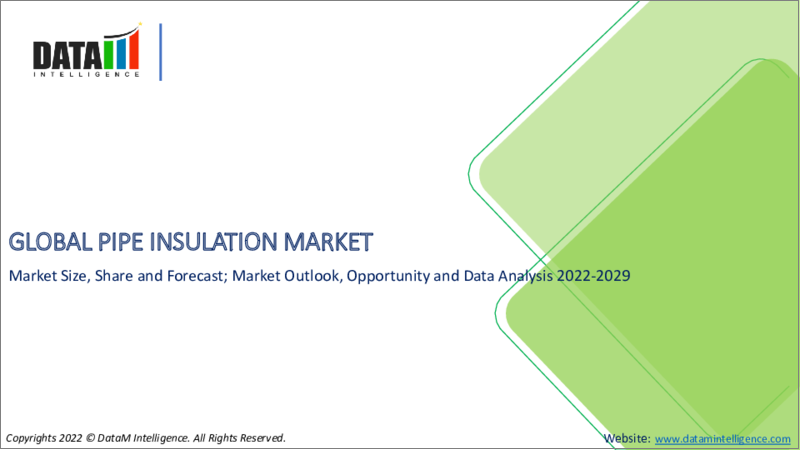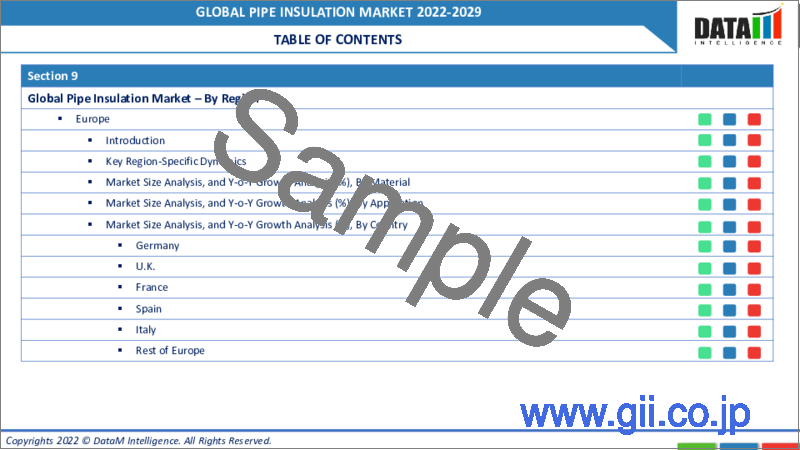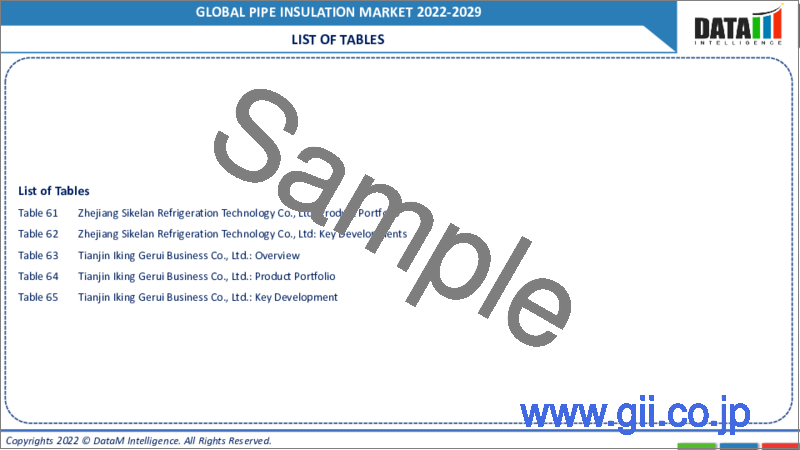|
|
市場調査レポート
商品コード
1138392
パイプ断熱材の世界市場-2022-2029Global Pipe Insulation Market - 2022-2029 |
||||||
|
● お客様のご希望に応じて、既存データの加工や未掲載情報(例:国別セグメント)の追加などの対応が可能です。 詳細はお問い合わせください。 |
|||||||
| パイプ断熱材の世界市場-2022-2029 |
|
出版日: 2022年10月18日
発行: DataM Intelligence
ページ情報: 英文 180 Pages
納期: 約2営業日
|
- 全表示
- 概要
- 目次
市場力学
環境に優しい建築物への需要の高まりがパイプ断熱材市場の成長を牽引
世界の建設部門は、アジア太平洋地域に焦点を当てた場合、インドやインドネシアなどの新興経済国で力強く成長すると予想されます。欧州では、英国が建設業の成長市場として際立っています。中南米では、ブラジル、アルゼンチン、メキシコなどの新興国が高い成長を遂げると予想されています。さらに、建設部門におけるグリーンビルディングの需要の高まりが、主にパイプ断熱材の成長を牽引すると予想されます。最近の調査では、世界のグリーンビルディング活動は上昇を続けており、今後3年間で約19カ国で大幅な増加が見込まれていることが強調されています。回答者のほぼ半数が、2021年までに自社プロジェクトの60%をグリーンビルディングにすると予想しています。建築物の所有者は、グリーンビルディングの成長に期待を寄せており、57%が2021年までにプロジェクトのほとんどをグリーンビルディングにすることを計画しています。このような建設部門の増加やグリーンビルディングの開発範囲の拡大により、パイプ断熱材の需要が世界的に高まると予想されます。
また、ポリウレタンフォームの生産に対する厳しい規制が高まっています。ポリウレタンフォームの生産に関する米国EPA(米国環境保護庁)の規制が強化されています。1998年に制定された技術基準では、塩化メチレン、メチルクロロホルム、2,4-トルエンジイソシアネート(TDI)、メチレンジフェニルジイソシアネート(MDI)、酸化プロピレン、ジエタノールアミン、メタノール、メチルエチルケトン、トルエンが規制対象になっています。塩化メチレンは、産業界からの有害大気汚染物質排出量の98%以上を占めています。このような規制は、メーカーが世界中でパイプ断熱材の生産を増加させるための主な課題となっています。市場セグメンテーション。ポリウレタン&ポリイソシアヌレートフォームセグメントは、世界のパイプ断熱材市場で最高のシェアを占めています。
ポリウレタン&ポリイソシアヌレートフォームセグメントは、予測期間において世界市場の最大シェアを占めると予想されます。ポリウレタン&ポリイソシアヌレートフォームは、低温または高温の液体を運ぶために使用されるパイプラインを絶縁するために徐々に使用されています。これらの材料はまた、チャネルとその周囲内の熱交換率を低減するために使用されています。この材料の主な応用分野には、化学プラント、石油・ガスパイプライン、地域エネルギーシステムなどがあります。
セルラーガラスは、推定・予測期間中に大きな成長を遂げると考えられています。この材料は、優れた強度、耐腐食性、ゼロ蒸気透過性、耐湿性などの優れた特性を備えており、こうした利点により、屋外や地下の様々な用途で需要が拡大すると予測されます。
地域エネルギーシステム分野は、同市場で2番目に急成長している分野と推定されます。これらのシステムは、再生可能エネルギー、廃熱、蓄熱、ヒートポンプ、サーマルグリッドの送電網を接続する実用的なアプローチとして世界中で採用されており、それによって持続可能な冷房・暖房を確保しています。さらに、これらのシステムはエネルギー効率の高いソリューションであり、通常のボイラーよりも二酸化炭素排出量が少なくて済みます。世界の環境意識の高まりと、エネルギー効率の高いソリューションに対する需要の高まりが、地域エネルギーシステムの世界の需要を後押ししています。
目次
第1章 調査手法と調査範囲
- 調査手法
- 調査目的および調査範囲
第2章 市場の定義と概要
第3章 エグゼクティブサマリー
- 素材別市場内訳
- アプリケーション別市場内訳
- 地域別市場内訳
第4章 市場力学
- 市場影響要因
- 促進要因
- 産業界における断熱材の需要拡大
- 断熱材は、エネルギー効率の向上、熱損失の削減、CO2排出量の最小化に貢献します。
- 電力、産業、石油・ガス、住宅など、さまざまな産業における配管断熱の導入に急速に影響。
- グリーンビルディングに対する需要の高まり
- 抑制要因
- ポリウレタンフォームの生産に関する厳しい規制の高まり
- ビジネスチャンス
- 影響分析
第5章 産業分析
- ポーターのファイブフォース分析
- サプライチェーン分析
- バリューチェーン分析
- PEST分析
- プライシング分析
- 法規制分析
- 保険償還分析
- アンメットニーズ
- 特許動向
第6章 COVID-19の分析
- COVID-19の市場分析
- COVID-19以前の市場シナリオ
- COVID-19の現在の市場シナリオ
- COVID-19の後、あるいは将来のシナリオ
- COVID-19の中での価格ダイナミクス
- 需要-供給スペクトラム
- パンデミック時の市場に関連する政府の取り組み
- メーカーの戦略的な取り組み
- まとめ
第7章 素材別
- セルラーガラス
- ポリウレタン&ポリイソシアヌレートフォーム
- ガラス繊維
- エラストマーフォーム
- その他
第8章 用途別
- 産業用
- 建築・建設
- 地域エネルギーシステム
第9章 地域別
- 北米
- 米国
- カナダ
- メキシコ
- 欧州
- ドイツ
- 英国
- フランス
- イタリア
- スペイン
- その他欧州
- 南米
- ブラジル
- アルゼンチン
- その他の南米地域
- アジア太平洋地域
- 中国
- インド
- 日本
- オーストラリア
- その他アジア太平洋地域
- 中東・アフリカ地域
第10章 競合情勢
- 競合シナリオ
- 市況ポジショニング/シェア分析
- M&A(合併・買収)分析
第11章 企業プロファイル
- Rockwool International A/S.
- 企業概要
- 製品ポートフォリオと説明
- 主なハイライト
- 財務概要
- Owens Corning
- Saint-Gobain
- Kingspan Group
- Armacell International S.A.
- Huntsman Corporation
- Johns Manville
- Knauf Insulation
- BASF SE
- Covestro AG
- Union Victory(HK)Industry Co., Ltd
- Changzhou Andwin Refrigeration Equipment Co., Ltd
- Zhejiang Sikelan Refrigeration Technology Co., Ltd
- Tianjin Iking Gerui Business Co., Ltd.
第12章 DataM
Market Overview
Pipe Insulation Market was valued at USD XX million in 2021. It is forecasted to reach USD XX million by 2029, growing at a CAGR of 5 % during the forecast period (2022-2029).
Pipe insulation is a procedure of insulating pipes with different materials that protect lines. It also prevents heat gain or heat loss from the surfaces of the pipes and maintains the temperatures. Foam wraps, flexible films, and other rigid insulation materials are used to insulate pipes to protect the lines from heat and water or moisture, chemical interactions, corrosion, or other damages and breakage. Insulation products are extensively used in various industries such as paper, automotive, chemical, agriculture, and construction. Pipe insulation products can be flexible or rigid. The materials used to make the insulation products are wool, polyethylene, glass fiber, rubber, aluminum foil, and wood. Growing demand for insulation across the industries to enhance the industrial processes efficiency operating at extreme temperatures is primarily anticipated to support the market growth. Insulation assists in improving energy efficiency, reducing heat loss, and minimizing CO2 emissions. Besides, it also offers protection to pipelines at low temperatures, which rapidly influences pipe insulation adoption across various industries, including electric power, industrial, oil & gas, and residential.
Market Dynamics: Rising demand for green buildings drives pipe insulation market growth.
The global construction sector is expected to grow strong in emerging economies such as India and Indonesia when the focus comes to the Asia-pacific region. In Europe, the UK is a stand-out growth market for construction. In the Latin American area, developing countries such as Brazil, Argentina, and Mexico are expected to witness the construction sector's high growth. Moreover, the construction sector's rising green buildings demand is expected to drive pipe insulation's growth mainly. A recent survey highlight that global green building activity continued its ascent, with substantial increases in around 19 countries in the coming three years. Almost half of the total respondents expect 60% of their projects as green buildings by 2021. Building owners were mostly excited about green building growth, with 57% planning to make most of their projects green by 2021. Such an increase in the construction sector and the rising scope for green building development are expected to raise the demand for insulation pipes globally.
Also, rising strict regulations on polyurethane foams production. There are rising US EPA regulations (the United States Environmental Protection Agency) on polyurethane foams production. The original technology-based rule, issued in 1998, controlled methylene chloride emission, methyl chloroform, 2,4-toluene diisocyanate (TDI), methylene diphenyl diisocyanate (MDI), propylene oxide, diethanolamine, methanol, methyl ethyl ketone, and toluene. Methylene chloride comprised over 98% of the total hazardous air pollutant emissions from the industry. Such regulations are the main challenges for manufacturers to increase insulation pipe production across the world. Market Segmentation: The polyurethane & polyisocyanurate foam segment accounted for the highest share in global pipe insulation market.
The polyurethane & polyisocyanurate foam segment is expected to account for the global market's largest market share in the forecast period. Polyurethane & polyisocyanurate foam are progressively used to insulate pipelines used to carry cold or hot liquids. These materials are also used to reduce the heat exchange rate within the channel and its surroundings. The material's major application areas include chemical plants, oil & gas pipelines, and district energy systems.
The cellular glass material segment is estimated to grow at a significant rate in the forecast period. This material's superior properties include excellent strength, corrosion resistance, zero vapor permeability, and moisture resistance; such benefits are projected to promote its demand across various outdoor and underground applications.
The district energy system segment is estimated to be the second-fastest-growing segment in the market. These systems are adopted worldwide as a practical approach to connecting renewables, waste heat, thermal storage, heat pumps, and thermal grid power grids, thereby ensuring sustainable cooling and heating. Moreover, these systems are energy-efficient solutions that produce fewer carbon emissions than regular boilers. The rising environmental awareness globally and growing demand for energy-efficient solutions fuel the district energy systems demand worldwide.
Geographical Penetration: Asia Pacific is the dominating region during the forecast period.
The Asia Pacific has expected to dominate the market with the largest share in the global pipe insulation market throughout the forecast period. The market's growth is primarily due to the growing industrialization in emerging economies, such as China, Mexico, Vietnam, and India. The rapid urbanization, rising per capita disposable income, and growing district energy systems demand are expected to boost the pipe insulation market's growth. Moreover, the high growth in various industries such as food processing, pharmaceuticals, and chemicals is expected to enhance the demand for pipe insulation in the region over the forecast period.
Competitive Landscape:
The pipe insulation market is highly competitive, owing to the presence of competitors. The key pipe insulation players which are contributing to the growth of the global market include Rockwool International A/S, Owens Corning, Saint-Gobain, Kingspan Group, Armacell International S.A., Huntsman Corporation, Johns Manville, Knauf Insulation, BASF SE, Covestro AG, Union Victory (HK) Industry Co., Ltd, Changzhou Andwin Refrigeration Equipment Co., Ltd, Zhejiang Sikelan Refrigeration Technology Co., Ltd., and Tianjin Iking Gerui Business Co., Ltd., among others. The key companies are adopting new product launches and expansion strategies for global growth in the pipe insulation market. In August 2021, Owens Corning acquired Natural Polymers, LLC, a manufacturer of spray polyurethane foam insulation for building and construction applications. This acquisition helps to grow Owens Corning's business. Natural Polymers manufactures high-quality spray polyurethane foam products and systems, offering some of the lowest-volatile organic compound products available in the spray foam industry. In January 2022, Owens Corning acquired Wear Duck, a premium composite decking and structural lumber manufacturer. This acquisition helps to help to grow the composites business to focus on high-value material solutions within the building and construction space. Some manufacturers launch a new product in the market to expand their product portfolio. For instance, in January 2020, Owens Corning launched next-gen fiberglass insulation. This product is made from Pure Fiber Technology. This product has properties like Non-combustible, Soft to the touch. In February 2022, Saint-Gobain, through its subsidiary CertainTeed LLC invested $32 million to upgrade equipment at its insulation plant in California. This facility expands its production capacity by 13%. Also, this new equipment consumes less electricity and reduces the facility's carbon footprint by more than 4,000 metric tons per year.
COVID-19 Impact: Negative impact on the global pipe insulation market.
COVID-19 virus outburst has widely affected the global market economies in many terms, such as directly affecting supply chain disruption, production and demand, and financial impact. Moreover, the COVID-19 pandemic has directly impacted the manufacturers' supply chain worldwide with the shutdown and lockdown policies to reduce the virus's risk. Therefore, the key global manufacturers invest in the insulation pipes' production to meet the international market's updated demand.
Despite the pandemic, there is an expectation of the overall construction industry's growth, which is expected to drive the pipe insulation's market size in the global market during the forecast period.
Table of Contents
1. Methodology and Scope
- 1.1. Research Methodology
- 1.2. Research Objective and Scope of the Report
2. Market Definition and Overview
3. Executive Summary
- 3.1. Market Snippet by Material
- 3.2. Market Snippet by Application
- 3.3. Market Snippet by Region
4. Market Dynamics
- 4.1. Market Impacting Factors
- 4.2. Drivers
- 4.2.1. Growing demand for insulation across industries
- 4.2.2. Insulation assists in improving energy efficiency, reduce heat loss, and minimize CO2 emissions.
- 4.2.3. Rapidly influences pipe insulation adoption across various industries, including electric power, industrial, oil & gas, and residential.
- 4.2.4. Rising demand for green buildings
- 4.3. Restraints:
- 4.3.1. Rising strict regulations on the polyurethane foams production
- 4.4. Opportunity
- 4.5. Impact Analysis
5. Industry Analysis
- 5.1. Porter's Five Forces Analysis
- 5.2. Supply Chain Analysis
- 5.3. Value Chain Analysis
- 5.4. PEST Analysis
- 5.5. Pricing Analysis
- 5.6. Regulatory Analysis
- 5.7. Reimbursement Analysis
- 5.8. Unmet Needs
- 5.9. Patent Trends
6. COVID-19 Analysis
- 6.1. Analysis of Covid-19 on the Market
- 6.1.1. Before COVID-19 Market Scenario
- 6.1.2. Present COVID-19 Market Scenario
- 6.1.3. After COVID-19 or Future Scenario
- 6.2. Pricing Dynamics Amid Covid-19
- 6.3. Demand-Supply Spectrum
- 6.4. Government Initiatives Related to the Market During Pandemic
- 6.5. Manufacturers Strategic Initiatives
- 6.6. Conclusion
7. By Material
- 7.1. Introduction
- 7.1.1. Market Size Analysis, and Y-o-Y Growth Analysis (%), By Material Segment
- 7.1.2. Market Attractiveness Index, By Material Segment
- 7.2. Cellular Glass*
- 7.2.1. Introduction
- 7.2.2. Market Size Analysis, and Y-o-Y Growth Analysis (%)
- 7.3. Polyurethane & Polyisocyanurate Foam
- 7.4. Fiberglass
- 7.5. Elastomeric Foam
- 7.6. Others
8. By Application
- 8.1. Introduction
- 8.1.1. Market Size Analysis, and Y-o-Y Growth Analysis (%), By Application Segment
- 8.1.2. Market Attractiveness Index, By Application Segment
- 8.2. Industrial*
- 8.2.1. Introduction
- 8.2.2. Market Size Analysis, and Y-o-Y Growth Analysis (%)
- 8.3. Building & Construction
- 8.4. District Energy System
9. By Region
- 9.1. Introduction
- 9.2. Market Size Analysis, and Y-o-Y Growth Analysis (%), By Region
- 9.3. Market Attractiveness Index, By Region
- 9.4. North America
- 9.4.1. Introduction
- 9.4.2. Key Region-Specific Dynamics
- 9.4.3. Market Size Analysis, and Y-o-Y Growth Analysis (%), By Material
- 9.4.4. Market Size Analysis, and Y-o-Y Growth Analysis (%), By Application
- 9.4.5. Market Size Analysis, and Y-o-Y Growth Analysis (%), By Country
- 9.4.5.1. The U.S.
- 9.4.5.2. Canada
- 9.4.5.3. Mexico
- 9.5. Europe
- 9.5.1. Introduction
- 9.5.2. Key Region-Specific Dynamics
- 9.5.3. Market Size Analysis, and Y-o-Y Growth Analysis (%), By Material
- 9.5.4. Market Size Analysis, and Y-o-Y Growth Analysis (%), By Application
- 9.5.5. Market Size Analysis, and Y-o-Y Growth Analysis (%), By Country
- 9.5.5.1. Germany
- 9.5.5.2. The U.K.
- 9.5.5.3. France
- 9.5.5.4. Italy
- 9.5.5.5. Spain
- 9.5.5.6. Rest of Europe
- 9.6. South America
- 9.6.1. Introduction
- 9.6.2. Key Region-Specific Dynamics
- 9.6.3. Market Size Analysis, and Y-o-Y Growth Analysis (%), By Material
- 9.6.4. Market Size Analysis, and Y-o-Y Growth Analysis (%), By Application
- 9.6.5. Market Size Analysis, and Y-o-Y Growth Analysis (%), By Country
- 9.6.5.1. Brazil
- 9.6.5.2. Argentina
- 9.6.5.3. Rest of South America
- 9.7. Asia Pacific
- 9.7.1. Introduction
- 9.7.2. Key Region-Specific Dynamics
- 9.7.3. Market Size Analysis, and Y-o-Y Growth Analysis (%), By Material
- 9.7.4. Market Size Analysis, and Y-o-Y Growth Analysis (%), By Application
- 9.7.5. Market Size Analysis, and Y-o-Y Growth Analysis (%), By Country
- 9.7.5.1. China
- 9.7.5.2. India
- 9.7.5.3. Japan
- 9.7.5.4. Australia
- 9.7.5.5. Rest of Asia Pacific
- 9.8. The Middle East and Africa
- 9.8.1. Introduction
- 9.8.2. Key Region-Specific Dynamics
- 9.8.3. Market Size Analysis, and Y-o-Y Growth Analysis (%), By Material
- 9.8.4. Market Size Analysis, and Y-o-Y Growth Analysis (%), By Application
- 9.8.5. Market Size Analysis, and Y-o-Y Growth Analysis (%), By Country
10. Competitive Landscape
- 10.1. Competitive Scenario
- 10.2. Market Positioning/Share Analysis
- 10.3. Mergers and Acquisitions Analysis
11. Company Profiles
- 11.1. Rockwool International A/S.*
- 11.1.1. Company Overview
- 11.1.2. Product Portfolio and Description
- 11.1.3. Key Highlights
- 11.1.4. Financial Overview
- 11.2. Owens Corning
- 11.3. Saint-Gobain
- 11.4. Kingspan Group
- 11.5. Armacell International S.A.
- 11.6. Huntsman Corporation
- 11.7. Johns Manville
- 11.8. Knauf Insulation
- 11.9. BASF SE
- 11.10. Covestro AG
- 11.11. Union Victory (HK) Industry Co., Ltd
- 11.12. Changzhou Andwin Refrigeration Equipment Co., Ltd
- 11.13. Zhejiang Sikelan Refrigeration Technology Co., Ltd
- 11.14. Tianjin Iking Gerui Business Co., Ltd.
12. DataM Intelligence
- 12.1. Appendix
- 12.2. About Us and Services
- 12.3. Contact Us




